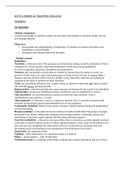Class notes
nutrion
- Course
- Institution
Human nutrition: is the study of food in relation to health of individual and groups of people particularly the infants, adolescents, pregnant and lactating mothers (vulnerable groups) and functioning of the body organs and provide the energy the body requires. Food bio availability – reduced o...
[Show more]



